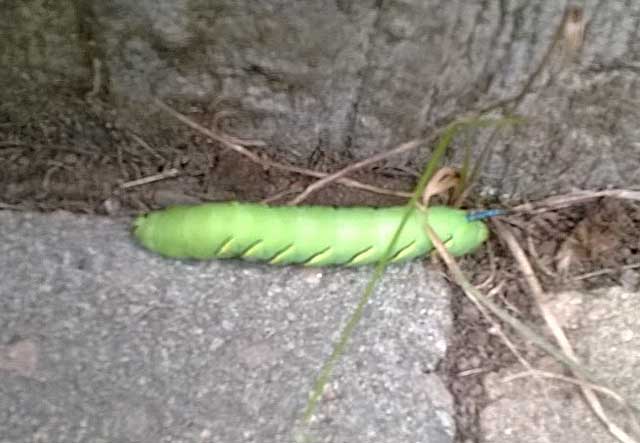Franklin County, Vermont
Sphingidae Larvae
Sphinx kalmiae, Georgia, Franklin County, Vermont,
September 16, 2013, courtesy of Mike Borden Sr., id by Bill Oehlke.
|
|
Updated as per James P. Tuttle's The Hawk Moths of North America, August 16, 2011 Updated/dedicated as per personal communication with Mike Borden Sr. (Sphinx kalmiae larva, Georgia, Franklin County), September 16, 2013 |

Sphinx kalmiae, Georgia, Franklin County, Vermont,
September 16, 2013, courtesy of Mike Borden Sr., id by Bill Oehlke.
Mike writes, "Found by my back door in Georgia, Vt. I have never seen these in Vermont. Should I be concerned?"
I reply, "Hi Mike, You have sent an image of a Sphinx kalmiae larva (caterpillar). Thanks fo rthinking of me.
"The caterpillar is harmless to humans, but it probably ate quite a bit of foliage from a nearby lilac bush. It has left the host plant, and is probably looking for some soft earth in which to excavate a tunnel and pupate
underground where it would spend the winter months in the pupal stage. The moth would emerge in the late spring or early summer."
Visit Franklin County Sphingidae: Adult Moths.
Visit Vermont Catocala: Underwing Moths.
It is hoped that this checklist, with the thumbnails and notes, will help you quickly identify the caterpillars (larvae) you are likely to encounter.
A "WO" after the species name indicates that I have no confirmed reports of this species in your county, but I (William Oehlke) expect that this moth is present or might be present.
Please help me develop this list with improved, documented accuracy by sending sightings (species, date, location), preferably with an electronic image, via email to Bill Oehlke.
Please also send sightings to BAMONA, an excellent online resource, via the link to the left.
For care of "found larvae/caterpillars" visit Manduca sexta August 21, 2008, Trina Woodall.
Sphinginae subfamily
courtesy of Mike Borden, Sr.
Smerinthini Tribe:
Macroglossinae subfamilyDilophonotini tribe:
Philampelini tribe:
Macroglossini tribe:
|
Enjoy some of nature's wonderments, giant silk moth cocoons. These cocoons are for sale winter and fall. Beautiful Saturniidae moths will emerge the following spring and summer. Read Actias luna rearing article. Additional online help available.
Use your browser "Back" button to return to the previous page.
This page is brought to you by Bill Oehlke and the WLSS. Pages are on space rented from Bizland. If you would like to become a "Patron of the Sphingidae Site", contact Bill.
Please send sightings/images to Bill. I will do my best to respond to requests for identification help.
 Show appreciation for this site by clicking on flashing butterfly to the left. The link will take you to a page with links to many insect sites. |
This website has been created and is maintained by Bill Oehlke without government or institutional financial assistance. All expenses, ie., text reference support material, webspace rental from Bizland, computer repairs/replacements, backups systems, software for image adjustments (Adobe Photoshop; L-View), ftp software, anti-virus protection, scanner, etc. are my own.
I very much appreciate all the many images that have been sent to me, or of which I have been granted permission to copy and post from other websites. All images on this site remain the property of respective photographers.
If you would like to contribute to the maintenace of this website by sending a contribution to
Bill Oehlke
Box 476
155 Peardon Road
Montague, Prince Edward Island, C0A1R0
Canada
your donation would be much appreciated and would be used for
1) paying for webspace rental;
2) paying for computer maintenance and software upgrades;
3) purchases of additional text reference material (journals and books) in anticipation of expanding the site to a worldwide Sphingidae site;
4) helping to pay my daughter's tuition (completed spring 2013); with anything left over going to humanitarian aid.
If you are mailing a check from USA, please use $1.10 postage (2013 rate). Donations can also be made through Paypal via the button below.